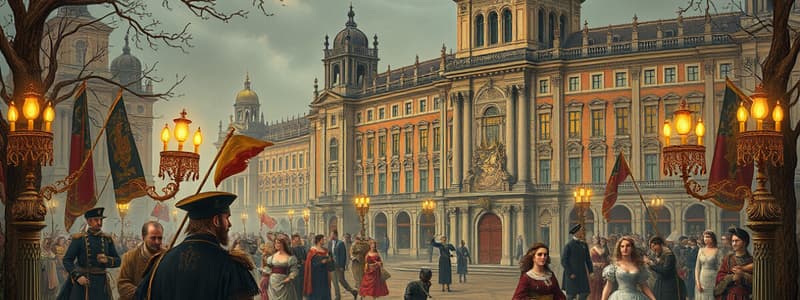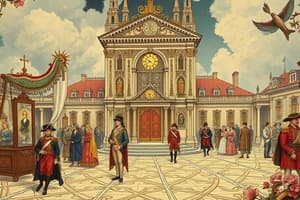Podcast
Questions and Answers
What was the primary goal of the Holy Alliance established after the Congress of Vienna?
What was the primary goal of the Holy Alliance established after the Congress of Vienna?
- To promote democratic reforms across Europe
- To expand territorial control
- To establish a coalition of republican governments
- To suppress future revolutions (correct)
Which class primarily championed liberalism during the 19th century European revolutions?
Which class primarily championed liberalism during the 19th century European revolutions?
- The clergy
- The nobility
- The bourgeoisie (correct)
- The working class
What immediate effect did the French Revolution of 1830 have on Europe?
What immediate effect did the French Revolution of 1830 have on Europe?
- The establishment of absolute monarchies
- A decline in socialist movements
- A wave of revolutions across several European countries (correct)
- The unification of various European monarchies
What was a significant demand during the revolutions of 1848?
What was a significant demand during the revolutions of 1848?
What did the revolutions of 1848 reveal about European society?
What did the revolutions of 1848 reveal about European society?
How did the established elites respond to the revolutionary movements in 1848?
How did the established elites respond to the revolutionary movements in 1848?
Which of the following was NOT a demand from the working class during this revolutionary period?
Which of the following was NOT a demand from the working class during this revolutionary period?
What impact did the revolutions of 1848 have on the political landscape of Europe?
What impact did the revolutions of 1848 have on the political landscape of Europe?
¿Cuál fue la reacción de las clases alta y burguesía a las revueltas de 1848?
¿Cuál fue la reacción de las clases alta y burguesía a las revueltas de 1848?
¿Qué clase social fue excluida del proceso político tras la restauración borbónica en Francia en 1830?
¿Qué clase social fue excluida del proceso político tras la restauración borbónica en Francia en 1830?
¿Qué evento se considera un precursor a las revoluciones de 1848 en Europa?
¿Qué evento se considera un precursor a las revoluciones de 1848 en Europa?
¿Qué demanda fue común entre las clases trabajadoras durante las revoluciones de 1848?
¿Qué demanda fue común entre las clases trabajadoras durante las revoluciones de 1848?
¿Cuál fue uno de los resultados de la ola de revoluciones en Europa en 1848?
¿Cuál fue uno de los resultados de la ola de revoluciones en Europa en 1848?
¿Qué fue la Santa Alianza y qué buscaba?
¿Qué fue la Santa Alianza y qué buscaba?
¿Qué caracterizó a la Revolución Francesa de 1830 en comparación con las anteriores?
¿Qué caracterizó a la Revolución Francesa de 1830 en comparación con las anteriores?
¿Cuál de las siguientes afirmaciones sobre las reformas post-revolucionarias es correcta?
¿Cuál de las siguientes afirmaciones sobre las reformas post-revolucionarias es correcta?
Study Notes
The Aftermath of Napoleon
- Victory of the anti-Napoleonic coalition culminated in the Congress of Vienna (1814–1815).
- The Congress restored pre-revolution borders and reestablished absolute monarchies across Europe.
The Holy Alliance
- Coalition formed by Prussia, Austria, and Russia aimed at suppressing future revolutions.
- Maintained the absolute monarchy structure in response to revolutionary ideals.
The Rise of Liberalism
- Ideals of the French Revolution permeated Europe despite opposition from the Holy Alliance.
- Emergence of a new bourgeois class, consisting of businessmen, merchants, and intellectuals, advocating for liberalism to safeguard their interests.
The French Revolution of 1830
- Liberal bourgeoisie successfully overthrew the Bourbon monarchy in France.
- Sparked a series of revolutions throughout Europe, challenging conservative regimes.
1848 - The Year of Revolutions
- A wave of revolutions in 1848 driven by economic discontent among the populace.
- The working class began organizing labor unions and engaging in political activities, influenced by earlier revolutions.
The Growing Influence of the People
- Demands for social and political reform intensified during this period.
- Workers Rights: Strikes and demonstrations called for reduced workdays, better wages, and representation in government.
- Voting Rights: Universal suffrage became a common demand, advocating the right to vote for all adults, irrespective of wealth.
- Democratic Systems: Growing liberal ideas prompted calls for constitutions that assured basic liberties and equal rights.
The Shift in Power
- Initial successes of revolutions were ultimately suppressed by established elites.
- Demonstrated the increasing power of the populace and the desire for substantial societal change.
- Tensions heightened between ruling elites and those advocating for democracy and social justice.
- Despite suppression, the revolutionary movements left a lasting impact, entrenching forces of liberalism, democracy, and social justice in Europe's political landscape.
The Post-Napoleonic Era: The Congress of Vienna
- The Congress of Vienna took place from 1814 to 1815 after the defeat of Napoleon, restoring pre-Revolution borders.
- It re-established absolute monarchies that had been overthrown by Napoleon's campaigns.
The Holy Alliance
- Formed by Prussia, Austria, and Russia, the Holy Alliance aimed to suppress revolutionary movements throughout Europe.
- Despite their efforts, revolutionary ideas from the French Revolution permeated the continent, gaining traction among the bourgeoisie, such as entrepreneurs and intellectuals.
France: The Birthplace of Revolution
- France became the epicenter of revolutionary activity as the bourgeoisie sought to dismantle absolute monarchies.
- The revolutionary spirit triggered widespread impacts across Europe, inspiring similar movements.
The Bourbon Restoration and the Rise of the Middle Class
- In 1830, the bourgeoisie successfully established a constitutional monarchy, reflecting the elite's interests through a limited voting franchise.
- The middle class and working class remained politically marginalized, leading to growing discontent fueled by social and economic hardship.
- Key demands included the right to strike, shorter workdays, and universal suffrage for all citizens regardless of class.
Europe in 1848: A Wave of Revolutions
- The year 1848 experienced widespread revolutions across Europe, ignited by economic troubles like famines and unemployment.
- Initial successes were achieved by revolutionaries in various countries, but the upper classes and military swiftly restored order.
- Most liberal reforms sought by revolutionaries were temporary, as old regimes regained power with military support.
The Long Road to Democracy
- Following the 1848 revolutions, ongoing popular pressure for democratic reforms gradually expanded rights and representation.
- While the wealthy retained significant power, notable progress was made towards inclusive institutions and expansion of suffrage for all male citizens.
Studying That Suits You
Use AI to generate personalized quizzes and flashcards to suit your learning preferences.
Related Documents
Description
Explore the impact of Napoleon's defeat on Europe, including the formation of the Holy Alliance and the rise of liberalism. This quiz covers the revolutionary waves from the Congress of Vienna to the French Revolution of 1830 and the critical year of 1848. Test your knowledge on these pivotal historical events and their implications for the continent.




